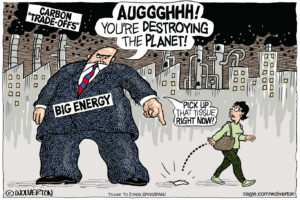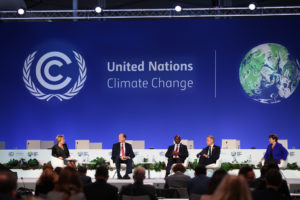Top Six Green Energy Good News Stories From the Paris COP21
World leaders signed the COP21 Paris climate accord on Friday -- Earth Day. In it is some good news on emissions, and new renewable energy installations are key.
This post originally ran on Truthdig contributor Juan Cole’s website.
World leaders signed the COP21 Paris climate accord on Friday, Earth Day. Whether it will be meaningful in stopping carbon dioxide emissions and emissions of other dangerous greenhouse gases that are warming our planet remains to be seen. But there is some good news on the emissions front, and new renewable energy installations are key to it.
1. The world’s production of carbon dioxide remained flat at 32.1 billion metric tons per annum for the second year in a row. In the past 25 years it has been rare for emissions not to grow, except in years of severe economic downturn such as 2009. In 2012 and 2013 emissions grew by 4% a year. But in 2014 they grew by only 0.5%, and there was virtually no increase again in 2015. This stabilization of emissions took place even though the world economy continues to grow, demonstrating that the old fears about CO2 reductions being bad for the economy were misplaced. Moreover, it is thought by economists that the main reason for the flattening of emissions is the vast increase in wind, solar and other renewable sources of electricity. Renewables accounted for 90% of new electricity generation last year! You will see some analysts attribute the leveling off to the replacement of coal plants with natural gas power plants, but that change accounts for only a minor amount of the flattening. Many coal plants have been replaced, in Iowa and Texas, e.g., not with natural gas but with wind farms. Natural gas is said to emit only half as much CO2 as coal; but recent research suggests that natural gas drilling produces far more methane than had previously been thought, and methane is an extremely potent and dangerous greenhouse gas. Besides, solar and wind emit no carbon dioxide at all once their construction is paid for, and the fuel is free. One caveat: It is unsustainable for CO2 emissions to remain flat at 32.1 bn metric tons a year! The only way to mitigate the worst effects of climate change is to reduce global emissions. That hasn’t happened yet, and COP21 will remain a dead letter unless it does.
 h/t The Guardian
h/t The Guardian
2. India almost doubled its solar capacity in 2015, from 3.74 gigawatts to 6.75 gigawatts. (A gigawatt is a billion watts, i.e., equivalent to 10 million 100-watt light bulbs). It hopes to nearly triple its current capacity by the end of 2017. Photovoltaic panels have fallen in cost by 80% in the past 5 years.
3. Indian economists now figure that solar energy is cheaper than coal in India. Coal is usually figured to generate electricity at 5 cents a kilowatt hour, though if you took into account the environmental damage it does that would be more like 45 cents a kilowatt hour. New solar bids in some sunny places like Dubai have been let for 6 cents a kilowatt hour, so solar is certainly competitive with coal in places like India. Moreover, a solar farm can be built quickly and relatively inexpensively. India hopes to have 100 gigawatts of solar generating capacity by 2022. The US, the European Union, China and India are the world’s biggest carbon polluters, so if India can reduce its emissions it would be meaningful for the world and would also put a burden on the other three (whose emissions are much bigger) to do more in this regard.
4. Electricity generation is only part of the puzzle. Some 40% of transmission lines worldwide need to be replaced with Ultra High Voltage lines. China has announced plans to build out its grid to neighbors like Japan, South Korea and Russia, and ultimately all the way to Europe, with an eye to ensuring massive savings. (Cheap wind-generated electricity might be stuck on a Pacific coast far from the cities that need it without these transmission lines). Since China is a leader in renewables, it even hopes to make money on the the transition away from hydrocarbons by selling its excess electricity to neighbors. Long distance transmission of electricity only involves a loss of about 7%. The ability to export excess electricity to places it is needed also works against deflation in the renewables markets.
5. China spent $103 billion on renewable energy installations in 2015, 36% of the world total and more than the US, Japan, and the UK put together. China is currently the biggest emitter in absolute terms, though the US far exceeds it on a per capita basis.
6. China’s CCTV reports that 63% of new power plants built in China in 2015 were non-fossil fuel. Joanna Lewis of Georgetown University explained, “That means primarily wind, followed by hydro, followed by solar and nuclear fourth. That’s a real change, where you go back ten years ago and China was building almost 100 gigawatts a year of new coal plants, that number has dropped dramatically.”
Of course what the world needs is for all new power plants to be non-fossil fuels. We have to keep it in the ground.
Your support matters…Independent journalism is under threat and overshadowed by heavily funded mainstream media.
You can help level the playing field. Become a member.
Your tax-deductible contribution keeps us digging beneath the headlines to give you thought-provoking, investigative reporting and analysis that unearths what's really happening- without compromise.
Give today to support our courageous, independent journalists.





